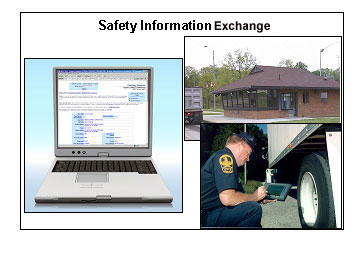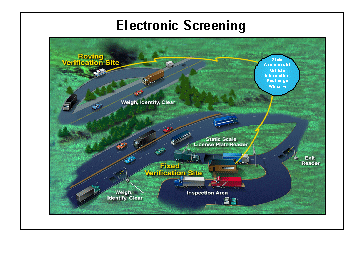|
|
|
|
|
|
The definition of Core CVISN requirements are as follows: - An organizational framework for cooperative system development has been established among state agencies and motor carriers.
- A state CVISN System Design has been established that conforms to the CVISN Architecture and can evolve to include new technology and capabilities.
- All the elements of the three capability areas have been implemented using applicable architectural guidelines, operational concepts, and standards.
Click on the Core CVISN capabilities below: At a high level, deployment of Core CVISN capabilities refers to - Electronically collecting and exchanging safety performance and credentials information within the state and among states, federal agencies, and motor carriers;
- Deploying transponder technology to identify and electronically screen commercial vehicles at mainline speeds; and
- Using Web sites or computer-to-computer exchange for motor carrier companies to apply for, review and pay registration fees and returns on fuel taxes with state agencies and for states to participate in the International Registration Plan (IRP) and International Fuel Tax Agreement (IFTA) clearinghouses.
Specifically, the Core CVISN capabilities are:  Safety Information Exchange Safety Information Exchange- Inspection reporting using ASPEN (or equivalent) at all major inspection sites. ASPEN data sent to SAFER (Safety and Fitness Electronic Records) directly or indirectly.
- Connection to the SAFER system to provide exchange of interstate carrier and vehicle data snapshots among states.
- Implementation of CVIEW (Commercial Vehicle Information Exchange Window) (or CVIEW equivalent) system for exchange of intrastate and interstate data within state and connection to SAFER for exchange of interstate data through snapshots.
OR - Utilization of SAFER option for exchange of inter- and intrastate data through snapshots.

Credentials Administration - Automated electronic processing via Web-based or computer-to-computer solutions from carrier to state (processing includes carrier application, state application processing, credential issuance, and tax filing) of at least IRP (International Registration Plan) and IFTA (International Fuel Tax Agreement) credentials; ready to extend to other credentials [intrastate, titling, OS/OW (Oversize/Overweight), carrier registration, HazMat]. Note: Processing does not necessarily include e-payment.
- Update SAFER with credential information for interstate credential information as actions are taken.
- Connection to IRP and IFTA Clearinghouses.
- At least 10% of the transaction volume handled electronically; ready to bring on more carriers as carriers sign up; ready to extend to branch offices where applicable.

Electronic Screening - Use snapshots to support screening decisions.
- Implemented at a minimum of one fixed or mobile inspection site.
- Ready to replicate at other sites.
|
|
|
|